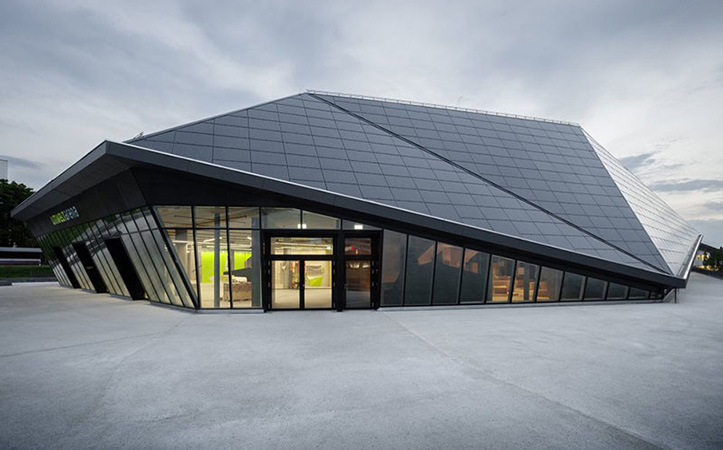Photovoltaic glass, also known as “photoelectric glass”. The utility model relates to a special glass which can press into solar photovoltaic modules, can generate electricity by solar radiation, and has related current extraction devices and cables. It consists of glass, solar cells, film, back glass, special metal wires, etc. It is one of the most innovative high-tech glass products for construction. It can withstand wind pressure and large temperature difference between day and night.
Solar photovoltaic glass is a special glass that can use solar radiation to generate electricity by laminating into solar cells, and has related current extraction devices and cables. It is composed of low-iron glass, solar cell, film, back glass, and special metal wire. The solar cell is sealed between a piece of low-iron glass and a piece of back glass through the film. It is the most novel architectural high-tech glass products. The use of low-iron glass to cover the solar cells can ensure high solar light transmittance. The tempered low-iron glass also has stronger resistance to wind pressure and the ability to withstand large temperature differences between day and night.
Photovoltaic glass is a special glass that can use solar radiation to generate electricity by laminating into solar cells, and has associated current extraction devices and cables. It has the advantages of beautiful appearance, controllable light transmission, energy-saving power generation and it does not require fuel, no waste gas, no waste heat, no waste residue, no noise pollution, and is widely used, such as: solar smart windows, solar pavilions and photovoltaic glass building ceilings , as well as photovoltaic glass curtain wall and so on. Photovoltaic glass can be divided into two categories: crystalline silicon photovoltaic glass and thin film photovoltaic glass. Among them, crystalline silicon is the most commonly used for curtain walls, and it is divided into two categories: monocrystalline silicon and polycrystalline silicon.
Features:
- Energy saving – Since the photoelectric curtain wall is used as the outer protection system of the building and directly absorbs the solar energy, it avoids the high temperature of the wall and the roof, which can effectively reduce the temperature rise of the wall and the roof, reduce the air-conditioning load, and reduce the energy consumption of the air-conditioning. .
- Protect the environment – the photovoltaic curtain wall generates electricity through solar energy, it does not need fuel, no waste gas, no waste heat, no waste residue, and no noise pollution.
- New and practical – relieve the power demand during the peak period of electricity consumption during the day, and solve the power supply situation in areas with power shortages and areas without electricity and low electricity. It can generate electricity and use in-situ, reducing the cost and energy consumption of the current transportation process; at the same time, it avoids the additional occupation of valuable building space for placing photovoltaic array panels, and integrates with the building structure, eliminating the need for a separate support structure for photovoltaic equipment. , but also between expensive exterior decoration materials, reducing the overall cost of the building.
- Special effects – The photoelectric curtain wall itself has a strong decorative effect. Various photovoltaic modules are used in the middle of the glass, and the colors are various, which makes the building have rich artistic expression. At the same time, the back of the photoelectric template can also be lined with the designer’s favorite color to adapt to different architectural styles.
advantage:
Photovoltaic glass has the advantages of beautiful appearance, controllable light transmission, energy-saving power generation without fuel, no waste gas, no waste heat, no waste residue, no noise pollution, etc. Wide range of applications, such as solar smart windows, solar pavilions and photovoltaic glass building roofs, and photovoltaic glass curtain walls, etc. It is divided into two categories: crystalline silicon photovoltaic glass and thin film photovoltaic glass. The former is divided into two categories: monocrystalline silicon and polycrystalline silicon, which are often used as curtain wall materials.
- Address
No.3 Beishang New City, GongShu District, Hangzhou China
-
Phone
+86-18072735884
-
Landline
+86-571-88688170

 English
English












